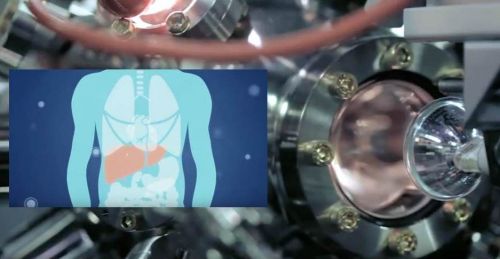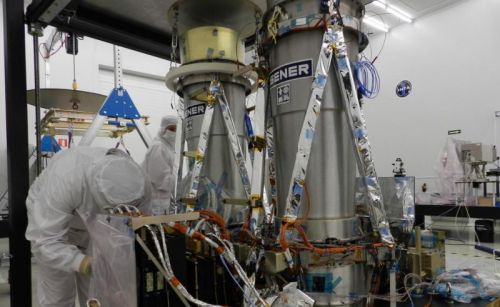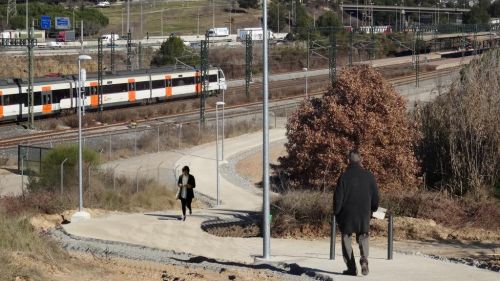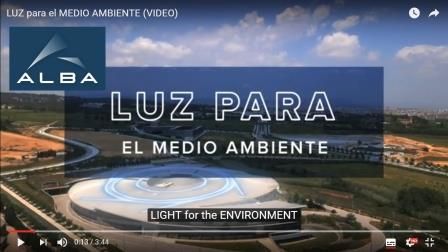News

09/02/2017
Hepatitis C Under the Watchful of ALBA Synchrotron
Hepatitis C Under the Watchful of ALBA Synchrotron
In the last recently released informative video about ALBA synchrotron, MISTRAL beamline researcher Ana Joaquina Pérez Berná, explains how X-rays produced by the electron accelerator allow understanding the action of drugs in liver cells infected with the Hepatitis C virus.
ALBA synchrotron MISTRAL beamline is an X-ray microscope that gives a tomography-based 3D vision of cells. This singular facility (only 4 synchrotrons offer this research tool worldwide) acts as a CT scan but with a 1 million times higher resolution.
In the framework of collaboration with the Biotechnology National Center (CNB-CSIC), Ana Joaquina and her colleagues observed healthy cells and compared their structures to both cells infected with Hepatitis C virus and infected cells treated with three different drugs. Observations have shown, among other things, how one of the three drugs has reversed the situation, turning an infected cell structure into a healthy cell one in only 7 days.
According to Ana Joaquina, MISTRAL offers a bridge experimental technic between classical biochemistry and experiments on mice and patients.
This video, together with other informative videos already released, is available on ALBA synchrotron Youtube channel.
ALBA synchrotron MISTRAL beamline is an X-ray microscope that gives a tomography-based 3D vision of cells. This singular facility (only 4 synchrotrons offer this research tool worldwide) acts as a CT scan but with a 1 million times higher resolution.
In the framework of collaboration with the Biotechnology National Center (CNB-CSIC), Ana Joaquina and her colleagues observed healthy cells and compared their structures to both cells infected with Hepatitis C virus and infected cells treated with three different drugs. Observations have shown, among other things, how one of the three drugs has reversed the situation, turning an infected cell structure into a healthy cell one in only 7 days.
According to Ana Joaquina, MISTRAL offers a bridge experimental technic between classical biochemistry and experiments on mice and patients.
This video, together with other informative videos already released, is available on ALBA synchrotron Youtube channel.

02/02/2017
The Barcelona Entrepreneurial Spirit Attracts Important Rounds of Funding
The Barcelona Entrepreneurial Spirit Attracts Important Rounds of Funding
2017 got off to a promising start in the Barcelona entrepreneurial ecosystem with an important round of funding completed by Letgo: last week, this company, which is settled in Barcelona and devoted to the Internet second-hand market, concluded the largest round among Spanish start-ups since 2010: Letgo raised $ 175 million (€ 163 millions).
In general, Barcelona attracts important investments of this kind: in Spain, in the last 7 years, 63% of rounds in technology start-ups larger than € 10 million ended up in Catalonia. A similar percentage is observed for the international venture capital invested in Spain: in 2015, 71% went to Catalonia according to The Spanish Venture Capital & Private Equity Association (ASCRI).
By the way, among the 10 largest rounds ever carried out in Spain, 8 have corresponded to Catalan companies such as Scytl (electronic voting) o Privalia (fashion web portal). The global amount of these rounds in Catalonia corresponds to € 928 million.
According to Inveready Technology Investment Group Director Carlos Conti, this attraction of venture capital to the Barcelona is due to the multiplier effect of the local entrepreneurial ecosystem that is able to attract large business investments and as a consequence, to conclude the largest rounds of funding of technology start-ups.
News based on an article by the Catalan newspaper Ara on January 29, 2017.
In general, Barcelona attracts important investments of this kind: in Spain, in the last 7 years, 63% of rounds in technology start-ups larger than € 10 million ended up in Catalonia. A similar percentage is observed for the international venture capital invested in Spain: in 2015, 71% went to Catalonia according to The Spanish Venture Capital & Private Equity Association (ASCRI).
By the way, among the 10 largest rounds ever carried out in Spain, 8 have corresponded to Catalan companies such as Scytl (electronic voting) o Privalia (fashion web portal). The global amount of these rounds in Catalonia corresponds to € 928 million.
According to Inveready Technology Investment Group Director Carlos Conti, this attraction of venture capital to the Barcelona is due to the multiplier effect of the local entrepreneurial ecosystem that is able to attract large business investments and as a consequence, to conclude the largest rounds of funding of technology start-ups.
News based on an article by the Catalan newspaper Ara on January 29, 2017.

26/01/2017
SENER, 50 Years In Space!
SENER, 50 Years In Space!
The SENER international engineering and technology group with Catalan headquarters in the Barcelona Synchrotron Park (BSP) celebrates its 50th year working in space. The launchers tower project in Kiruna, Sweden, was the first Space project that was tendered for in Spain, and it was SENER that did it, in 1967. This project clearly heralded starting point for SENER’s career in the space sector.
Since then, SENER currently had about 300 devices and subsystems in different satellites and space vehicles for agencies from the US (NASA), Europe (ESA), Japan (JAXA) and Russia (Roscosmos). Among the more recent projects, some famous missions can be mentioned: Rosetta (2004), Herschel & Planck (2009), Curiosity (2011), Gaia (2013), LISA Pathfinder (2015) or ExoMars 2020.
In the 4 worldwide centers where SENER carries out its space projects (BSP in Barcelona, Bilbao and Madrid, Spain, and Warsaw, Poland), SENER provides engineering and production services in electromechanical components and systems, guidance, navigation and control, and attitude and orbit control systems, optical system and microgravity and life support systems.
Regarding SENER future, Space and Defense director Diego Rodríguez said in a recent interview that “our mission now is to continue to supply subsystems for the flight segment while aiming for other areas, such as launchers, and branching out to projects with a lower institutional profile and a clear commercial focus”.
As part of the different activities that will be carried out to celebrate these 50 years in space, SENER organizes the so-called “Star trajectory” comic strip contest. Participants must present by February 3 a one-page color draft (portrait or landscape A4 size) with 3 to 9 drawings, free technique, in Spanish, original and unpublished (more information in Spanish here).
Since then, SENER currently had about 300 devices and subsystems in different satellites and space vehicles for agencies from the US (NASA), Europe (ESA), Japan (JAXA) and Russia (Roscosmos). Among the more recent projects, some famous missions can be mentioned: Rosetta (2004), Herschel & Planck (2009), Curiosity (2011), Gaia (2013), LISA Pathfinder (2015) or ExoMars 2020.
In the 4 worldwide centers where SENER carries out its space projects (BSP in Barcelona, Bilbao and Madrid, Spain, and Warsaw, Poland), SENER provides engineering and production services in electromechanical components and systems, guidance, navigation and control, and attitude and orbit control systems, optical system and microgravity and life support systems.
Regarding SENER future, Space and Defense director Diego Rodríguez said in a recent interview that “our mission now is to continue to supply subsystems for the flight segment while aiming for other areas, such as launchers, and branching out to projects with a lower institutional profile and a clear commercial focus”.
As part of the different activities that will be carried out to celebrate these 50 years in space, SENER organizes the so-called “Star trajectory” comic strip contest. Participants must present by February 3 a one-page color draft (portrait or landscape A4 size) with 3 to 9 drawings, free technique, in Spanish, original and unpublished (more information in Spanish here).

19/01/2017
Barcelona Synchrotron Park Even Closer
Barcelona Synchrotron Park Even Closer
With the aim to improving its connexion, Barcelona Synchrotron Park (BSP) has recently finished the construction of a new paved and lit access path that allows pedestrians and cyclists that arrive by train at the Cerdanyola Universitat station to get to BSP in 10 minutes walking.
In this way, Rodalies trains on R7 line that come from Barcelona and end their route at Cerdanyola Universitat and trains on R8 line (Martorell-Granollers) that also stop at this station help improve BSP connectivity.
Two train stations allow now an easy way to get to BSP: the Cerdanyola Universitat station as just mentioned and also the Bellaterra station. At this station where FGC trains on S2 and S55 lines (Barcelona-Sabadell) stop, a bus shuttle chartered by BSP drops people off in the park in 10 minutes driving through the UAB University.
Welcome to BSP!
In this way, Rodalies trains on R7 line that come from Barcelona and end their route at Cerdanyola Universitat and trains on R8 line (Martorell-Granollers) that also stop at this station help improve BSP connectivity.
Two train stations allow now an easy way to get to BSP: the Cerdanyola Universitat station as just mentioned and also the Bellaterra station. At this station where FGC trains on S2 and S55 lines (Barcelona-Sabadell) stop, a bus shuttle chartered by BSP drops people off in the park in 10 minutes driving through the UAB University.
Welcome to BSP!

11/01/2017
ALBA Synchrotron Is Also a Tool for the Environment
ALBA Synchrotron Is Also a Tool for the Environment
Environment, health, food, cultural heritage ... ALBA synchrotron's users coming from universities and research centres explain in short videos how they have taken advantage of the synchrotron light and how it can benefit for their research.
The fourth of these videos posted on line just before Christmas is focused on environmental issues. Jordi Llorca, professor at the Universitat Politècnica de Catalunya (UPC), explains how the study, design and production of new catalysts can have a positive impact on environment. In that case, Jordi Llorca and his team have used the ALBA synchrotron CIRCE beamline, a variable polarization soft X-ray beamline dedicated to advanced photoemission experiments.
Thanks to CIRCE, these researchers have successfully analyzed the surfaces and the mechanisms of action of catalyst nanoparticles in conditions very close to actual conditions of use. These results allow the design of new catalysts, especially in two domains of special interest for Jordi Llorca’s team: catalysts to produce hydrogen and catalysts to oxidize the carbon soot emitted by diesel engines.
Please follow the ALBA’s Youtube channel to watch the complete series of these outreach videos. They are filmed in Spanish and Catalan, although subtitles are available in English, Catalan and Spanish using the Settings button and in many more languages with the Auto-translate option.
The fourth of these videos posted on line just before Christmas is focused on environmental issues. Jordi Llorca, professor at the Universitat Politècnica de Catalunya (UPC), explains how the study, design and production of new catalysts can have a positive impact on environment. In that case, Jordi Llorca and his team have used the ALBA synchrotron CIRCE beamline, a variable polarization soft X-ray beamline dedicated to advanced photoemission experiments.
Thanks to CIRCE, these researchers have successfully analyzed the surfaces and the mechanisms of action of catalyst nanoparticles in conditions very close to actual conditions of use. These results allow the design of new catalysts, especially in two domains of special interest for Jordi Llorca’s team: catalysts to produce hydrogen and catalysts to oxidize the carbon soot emitted by diesel engines.
Please follow the ALBA’s Youtube channel to watch the complete series of these outreach videos. They are filmed in Spanish and Catalan, although subtitles are available in English, Catalan and Spanish using the Settings button and in many more languages with the Auto-translate option.

05/01/2017
Barcelona & Catalonia Startup Hub, the Catalan startups showcase
Barcelona & Catalonia Startup Hub, the Catalan startups showcase
At the end of last year, the Government of Catalonia presented the Barcelona & Catalonia Startup Hub, a virtual tool that identifies more than 1,000 Catalan startups with high growth potential. This platform was created with the aim of promoting the Catalan startup ecosystem internationally and to be a factor in investment attraction into these companies.
The startups.catalonia.com platform is the result of a year-long analysis to select and to get a clear picture of the startup community in Catalonia, one of the most dynamic in Europe. In fact, Barcelona is the 5th European region in terms of startups in accordance with various international rankings, such as EU-Startups or Startup Heatmap Europe.
The directory includes startups already established, emerging companies, no more than 10 years old, with a scalable business model, repeatable and applicable to global environments, aimed at rapid growth and founded by entrepreneurs (not corporations). The platform includes today the profile of 1,107 startups and also publishes the latest investment operations in Catalan startups as well as the operations known as exits (companies that have been purchased or have started trading on the stock exchange).
According to the platform, Catalan startups total nearly 10,000 workers and a global turnover of some 1,300 million euros. The majority work in the sectors of Internet and mobile software, ecommerce, tourism and leisure, big data and eHealth.
The startups.catalonia.com platform is the result of a year-long analysis to select and to get a clear picture of the startup community in Catalonia, one of the most dynamic in Europe. In fact, Barcelona is the 5th European region in terms of startups in accordance with various international rankings, such as EU-Startups or Startup Heatmap Europe.
The directory includes startups already established, emerging companies, no more than 10 years old, with a scalable business model, repeatable and applicable to global environments, aimed at rapid growth and founded by entrepreneurs (not corporations). The platform includes today the profile of 1,107 startups and also publishes the latest investment operations in Catalan startups as well as the operations known as exits (companies that have been purchased or have started trading on the stock exchange).
According to the platform, Catalan startups total nearly 10,000 workers and a global turnover of some 1,300 million euros. The majority work in the sectors of Internet and mobile software, ecommerce, tourism and leisure, big data and eHealth.









